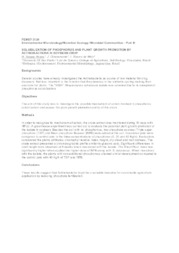Solubilization of phosphorus and plant growth promotion by actinobacteria in soybean crop.
Solubilization of phosphorus and plant growth promotion by actinobacteria in soybean crop.
Autoria: VARGAS-HOYOS, H. A.; CHIARAMONTE, J. B.; MELO, I. S. de
Resumo: Several studies have already investigated the Actinobacteria as source of raw material for drug discovery. Not less important is the function that they develop in the nutrients cycling making then available for plants. The ?3AS4? Streptomyces rishiriensis isolate was selected due to its exceptional phosphorus solubilization. The aim of this study was to investigate the possible mechanism of action involved in phosphorus solubilization and access the plant growth promotion ability of this strain. In order to recognize its mechanism of action, the crude extract was monitored during 10 days with HPLC. A greenhouse experiment was carried out to evaluate the potential plant growth promotion of the isolate in soybean. Besides the soil with no phosphorous, two phosphate sources: Triple super phosphate (TSP) and Rock phosphate Bayovar (RPB) were added at the soil. Inoculated pots were compared to control pots in the three concentrations of phosphates (0, 20 and 40 Kg/h). Evaluations considered the plants attributes; chlorophyll relative index, height, dry shoot and root biomass. The crude extract presented a chromatographic profile similar to gluconic acid. Significant differences in plant height were observed at 8 weeks when inoculated with the isolate. The Shoot/Root index was significantly higher when applied the higher dose of RPB along with S. rishiriensis. When inoculated with the isolate, the plants with non-additional phosphorous showed similar development compared to the control pots with 40 Kg/h of TSP and RPB. These results suggest that Actinobacteria might be a valuable resource for sustainable agriculture application by reducing phosphate fertilization.
Ano de publicação: 2018
Tipo de publicação: Resumo em anais e proceedings
Unidade: Embrapa Meio Ambiente
Palavras-chave: Actinobacteria, Fósforo, Soja
Observações
1 - Por padrão são exibidas publicações dos últimos 20 anos. Para encontrar publicações mais antigas, configure o filtro ano de publicação, colocando o ano a partir do qual você deseja encontrar publicações. O filtro está na coluna da esquerda na busca acima.
2 - Para ler algumas publicações da Embrapa (apenas as que estão em formato ePub), é necessário ter, no celular ou computador, um desses softwares gratuitos. Sistemas Android: Google Play Livros; IOS: iBooks; Windows e Linux: software Calibre.
Acesse outras publicações
Acesse a Base de Dados da Pesquisa Agropecuária (BDPA) para consultar o acervo completo das bibliotecas da Embrapa.

